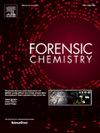New perspectives on THCA decarboxylation and accurate GC–MS quantitation of Total THC in Cannabis using analyte protectants
IF 2.6
3区 医学
Q2 CHEMISTRY, ANALYTICAL
引用次数: 0
Abstract
Forensic and commercial laboratories rely on well-characterized analytical methods to accurately determine total tetrahydrocannabinol (total THC), which is the sum of decarboxylated tetrahydrocannabinolic acid (THCA) and delta-9-tetrahydrocannabinol (Δ9-THC) in Cannabis sativa samples. The Agriculture Improvement Act of 2018 restricts the level of total THC allowed in Cannabis for classification as hemp for commercial purposes. Gas chromatography with mass spectrometry detection (GC–MS) is frequently employed for Cannabis measurements due to its simplicity and speed of analysis. However, several issues complicate the determination of total THC by GC–MS, which are well-documented but unresolved. In the current study, the origins of potential GC–MS method biases are investigated, and novel approaches are presented to mitigate interferences. The behavior of THCA and Δ9-THC during GC–MS analyses was studied extensively using test solutions containing their isotopically labeled analogs. A plant matrix effect was identified that significantly increased THCA and Δ9-THC responses for Cannabis extracts compared with calibrant solutions. A mechanism is proposed based on the interaction of THCA and Δ9-THC with silanols present on heated inlet surfaces. The use of active site blocking agents, known as analyte protectants, reduced these interactions and achieved suitable conditions for quantitation of total THC by GC–MS. When Cannabis plant extracts and calibrants were processed under the recommended conditions, the results were comparable to liquid chromatography with photodiode array (LC-PDA) analysis. The experimental findings ultimately provide evidence to explain the behavior of cannabinoids in the GC–MS system and offer new options for improving the accuracy of total THC measurements.
使用分析物保护剂对大麻中THCA脱羧和总THC的GC-MS准确定量研究的新进展
法医和商业实验室依靠特性良好的分析方法来准确测定大麻样品中的总四氢大麻酚(THC),即脱羧四氢大麻酚酸(THCA)和德尔塔-9-四氢大麻酚(Δ9-THC)的总和。2018年的《农业改进法》限制了大麻中允许的四氢大麻酚总量,将其归类为商业用途的大麻。气相色谱-质谱检测(GC-MS)由于其简单和分析速度快,经常用于大麻测量。然而,一些问题使气相色谱-质谱法测定总四氢大麻酚复杂化,这些问题有充分的文献记录,但尚未解决。在当前的研究中,研究了潜在的GC-MS方法偏差的来源,并提出了新的方法来减轻干扰。使用含有THCA和Δ9-THC同位素标记类似物的测试溶液,广泛研究了THCA和Δ9-THC在GC-MS分析中的行为。与校准溶液相比,植物基质效应显著提高了大麻提取物的THCA和Δ9-THC响应。提出了一种基于THCA和Δ9-THC与加热进口表面上存在的硅烷醇相互作用的机制。活性位点阻断剂(被称为分析物保护剂)的使用减少了这些相互作用,并为GC-MS定量总四氢大麻酚提供了合适的条件。当大麻植物提取物和校准剂在推荐的条件下处理时,结果与光电二极管阵列(LC-PDA)液相色谱分析相当。实验结果最终为解释大麻素在GC-MS系统中的行为提供了证据,并为提高总四氢大麻酚测量的准确性提供了新的选择。
本文章由计算机程序翻译,如有差异,请以英文原文为准。
求助全文
约1分钟内获得全文
求助全文
来源期刊

Forensic Chemistry
CHEMISTRY, ANALYTICAL-
CiteScore
5.70
自引率
14.80%
发文量
65
审稿时长
46 days
期刊介绍:
Forensic Chemistry publishes high quality manuscripts focusing on the theory, research and application of any chemical science to forensic analysis. The scope of the journal includes fundamental advancements that result in a better understanding of the evidentiary significance derived from the physical and chemical analysis of materials. The scope of Forensic Chemistry will also include the application and or development of any molecular and atomic spectrochemical technique, electrochemical techniques, sensors, surface characterization techniques, mass spectrometry, nuclear magnetic resonance, chemometrics and statistics, and separation sciences (e.g. chromatography) that provide insight into the forensic analysis of materials. Evidential topics of interest to the journal include, but are not limited to, fingerprint analysis, drug analysis, ignitable liquid residue analysis, explosives detection and analysis, the characterization and comparison of trace evidence (glass, fibers, paints and polymers, tapes, soils and other materials), ink and paper analysis, gunshot residue analysis, synthetic pathways for drugs, toxicology and the analysis and chemistry associated with the components of fingermarks. The journal is particularly interested in receiving manuscripts that report advances in the forensic interpretation of chemical evidence. Technology Readiness Level: When submitting an article to Forensic Chemistry, all authors will be asked to self-assign a Technology Readiness Level (TRL) to their article. The purpose of the TRL system is to help readers understand the level of maturity of an idea or method, to help track the evolution of readiness of a given technique or method, and to help filter published articles by the expected ease of implementation in an operation setting within a crime lab.
 求助内容:
求助内容: 应助结果提醒方式:
应助结果提醒方式:


